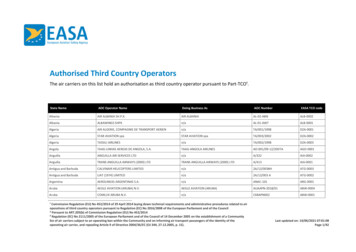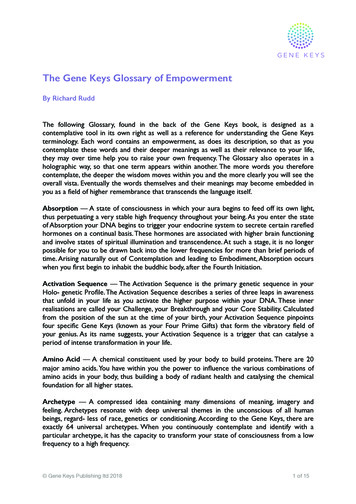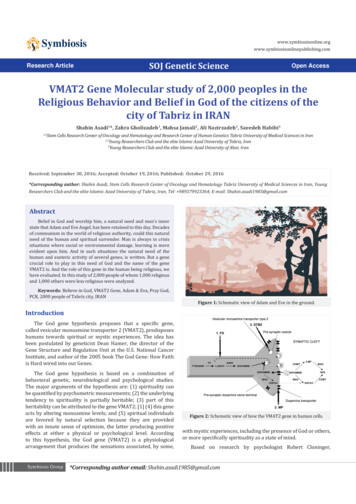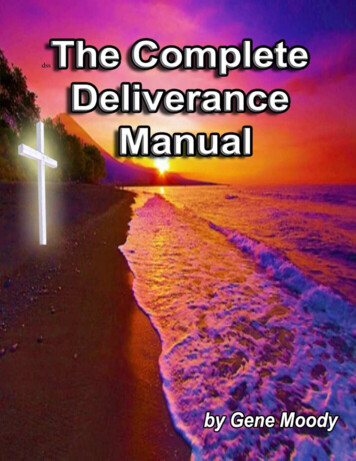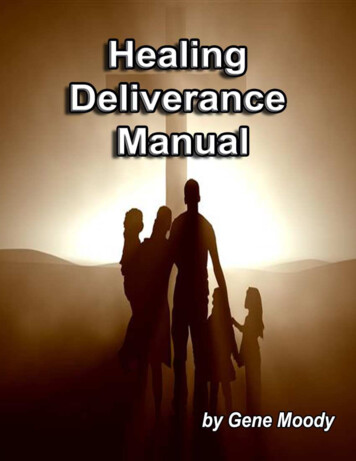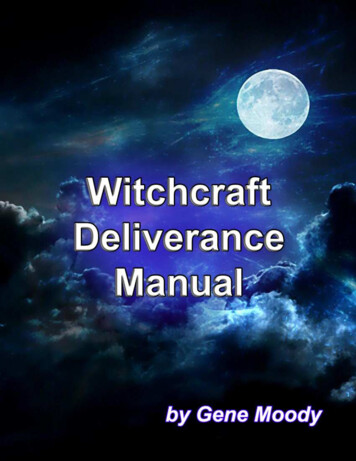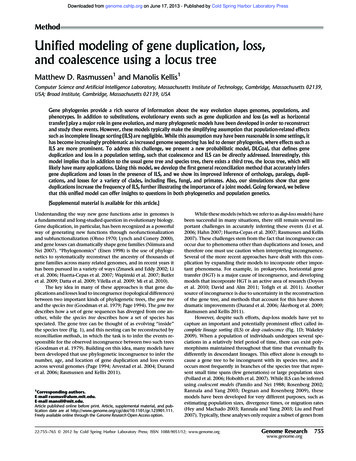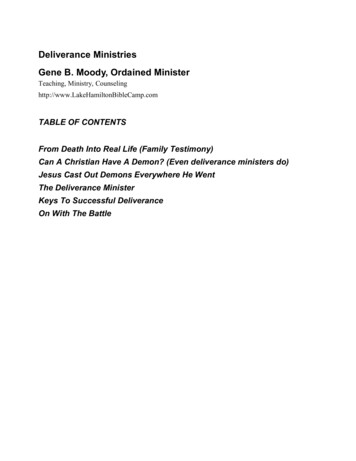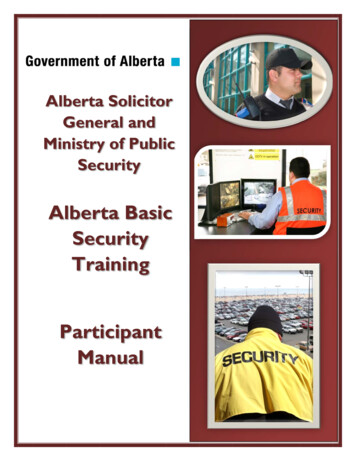
Transcription
Albbertaa SoliicitorrGeneG eral andaMinnistryy of PubliPcSeccurityyAllberrta BasicB cSeccurittyTraaininngPartP icipaantMaanuaal
(3rd ed. January, 2014) 2011, 2013, 2014 Government of Alberta, as represented by the Alberta Solicitor General andMinistry of Public Security, except where otherwise noted. All rights reserved. No part of thesematerials may be reproduced (including photocopying), stored in a retrieval system, ortransmitted, in any form or by any means, without the written permission of the Alberta SolicitorGeneral and Ministry of Public Security.Please notify the Alberta Solicitor General and Ministry of Public Security if any cases of copyrightinfringement are identified.Contact Information for copyright requests:Registrar, Security Services and Investigators ActAlberta Solicitor General and Ministry of Public Security10th Floor, 10365-97 StreetEdmonton, AB T5J 3W7Email: ssia.registrar@gov.ab.caFax: 780-427-4670Produced by:Lethbridge College3000 College Dr. SouthLethbridge, Alberta, Canada, T1K 1L6Educational Enhancement TeamCourse Writer:Subject MatterExpert:iStock PhotosErica Cormack, B.A.School of Justice StudiesPeter Ashworth, Instructor, Criminal JusticeDepartmentInstructional Designer:Diana QuirkFormatter:Shirley TrowbridgeMedia Specialist:Lyle RugglesAV Technician:Elio GirardiiStock photos from http://www.istockphoto.com. 2010. Used under licencewith iStockphoto . All rights reserved.Front cover photo numbers: 13204651; 11651074; 3783678Collage photo numbers: 11651074, 5543915; 2975188; 4491334; 5679834,11144261, 4381786All Federal Acts & Regulations of the Government of Canada are reproduced by permission ofthe Federal Reproduction Law Order (S1-97-5).Copyright 2004 Microsoft Corporation , One Microsoft Way, Redmond, Washington 980526399 U.S.A. Clipart reproduced with permission of Microsoft Corporation. All rights reserved.Produced for:The Alberta Solicitor General and Ministry of Public SecurityAlberta Solicitor General and Ministry of Public SecurityJan-14Alberta Basic Security TrainingCopyright
Alberta Solicitor General and Ministry of Public SecurityJan-14Alberta Basic Security TrainingCollage
Table of ContentsIntroductionLearning OutcomesIcons in This ManualModule One: Introduction to the Security IndustryRoles and Responsibilities of Security ProfessionalsLegislation and the Licensing of Security Professionals in AlbertaAppearance and Conduct for Security ProfessionalsModule Two: The Canadian Legal System and Security ProfessionalsCharter of Rights and the Criminal Code of CanadaUse of ForceAdditional LegislationModule Three: Basic Security ProceduresObservationPatrol SkillsDealing with Substance AbusersInteracting with the MediaTraffic ControlTraffic Collision ReportsPost OrdersStarting a ShiftEnding a ShiftWorking with a PartnerUse of Force ResponseModule Four: Communication for Security ProfessionalsVerbal and Non-Verbal CommunicationChallenges to CommunicationCommunicating with Uncooperative PersonsConducting an InterviewModule Five: Documentation and g for CourtModule Six: Response Procedures for Security ProfessionalsAlarm SystemsResponding to AlarmsEmergency Scene ManagementModule Seven: Health and Safety for Security ProfessionalsPersonal SafetyIdentifying HazardsShift WorkAlberta Solicitor General and Ministry of Public SecurityJan-14Alberta Basic Security TrainingTable of Contents
Alberta Basic Security TrainingIntroductionWelcome to the Alberta Basic Security Training course. Over the next five days, you willdevelop the knowledge and skills required of a security professional and, uponsuccessful completion of this course, you will be well-prepared to write the provinciallicensing exam. You will also be ready to take on a role in the security field.This course has been designed to provide you with an interactive learning experience.Studies show that individuals learn best when a variety of instructional methods areused. Therefore, in this course, you will participate in classroom lectures, guideddiscussions, practical exercises, and scenarios. The more you engage with theinstructional process, the more you will gain.During this course, you will become proficient in the skills required of a securityprofessional, including: Understanding of the law Basic patrol duties Communications Documentation Emergency scene managementThe goals of this course are to help you gain confidence in your abilities and to prepareyou to meet the challenges of working in security. The instructional materials andactivities have been designed to increase your knowledge of the daily duties andresponsibilities of a security professional. To that end, learning activities have beenstructured to resemble elements of the performance which will be expected of you in thefield. Use the opportunities for practice and feedback in this course to develop your skillswell before you need to use them.Learning OutcomesAt the end of this course, you will be able to1. Describe the components of dress, deportment, and behaviour required of a securityprofessional2. Explain federal and provincial legislation relevant to the work of a securityprofessional3. List the knowledge and skills required to perform basic patrol dutiesAlberta Solicitor General and Ministry of Public SecurityJan-14Alberta Basic Security TrainingIntroduction, Page 1
4. Apply a professional and effective communication style for managing and controllingincidents5. Demonstrate proficiency and accuracy in note-taking and report writing6. Explain how to manage an emergency situation7. Maintain personal safety and wellness while working as a security professionalThis course is delivered in seven modules; each module deals with specific topic areasand there are learning outcomes associated with each. The modules which make up theAlberta Basic Security Training course are: Module 1: Introduction to the Security Industry Module 2: The Canadian Legal System and Security Professionals Module 3: Basic Security Procedures Module 4: Communication for Security Professionals Module 5: Documentation and Evidence Module 6: Emergency Response Procedures for Security Professionals Module 7: Health & Safety for Security ProfessionalsIn order to receive a certificate indicating successful completion of this course, you mustattend all sessions of this training. You are required to provide evidence that you havecompleted forty (40) hours of training in basic security procedures in order to be eligibleto write the provincial licensing exam.In addition to this course participant manual, you will need the following items: Notebook Pen Copy of Security Services and Investigators Act S-4.7 2008Come prepared for class each day; you will be able to participate more actively and gainmore from your attendance if you have the required materials ready and waiting.In addition to being prepared for each class, please make note of the following: Arrive on time and plan to be in class until the designated finish time each day Get plenty of sleep each night; having adequate rest will help you learn and retainthe materials Turn your cell phone off during class time; it is disruptive for you and disrespectful ofthe facilitator when you frequently check your phone for messages Get to know your classmates; they will be your colleagues in the field and great studybuddies as the course progressesAlberta Solicitor General and Ministry of Public SecurityJan-14Alberta Basic Security TrainingIntroduction, Page 2
AskA questionss! The facilittator wants youy to be su ccessful; doon’t hesitate to seekcllarification oro additional explanation when you nneed it. It is YYOUR coursse; makesuure it is meeeting your neeeds. ReviewRafter each class; go over the day’s materrials while thhe informatioon is stillfrresh in your mind, and makemnotes in case you hhave questioons you’d likke to clear uppwithw the facilittator. Relax!RThis iss very importtant material, and it mayy look like a lot to cover in five days,,but this coursse has been designed too be interactiive; not intimmidating. Divve in withyoour questionns, your answwers, and yoour ideas – aactive particcipation is a kkey principleeinn successful, adult learning.Iconns in this manualThrouughout this manual,myou will see thee following iccons. Each tiime you seee one of thessesymbbols, you willl know a parrticular type ofo activity is going to takke place.Check Yoour Knowledgeedge about toopic areas ata the start off each new module.Test your knowleActivityThis willw be a hannds-on activity for you too complete.Discussioon ActivityyThis willw be a grooup discussioon based onn some aspeect of the toppic you are sstudying.Take a Mooment to ReflectThis willw be an acctivity designned to stimulate your crittical thinkingg ability.Albertaa Solicitor Generaal and Ministry off Public SecurityJan-14Alberta Basicc Security TraininngIntroduction, Pagee3
Videow watch a video as part of an instrructional actiivity.You willPost-TesttThis willw help youu assess youur progress throughtthe course.You’vve made thee first step too a career ass a security pprofessional by enrollingg in thiscoursse. Over the next five daays of instrucction, you caan expect to be informedd, engaged,and challengedcbyb the materrial in this course. Considder this pracctice for yourr entry intothe ever-changing and alwayys interestingg role of a liccensed secuurity professiional.Albertaa Solicitor Generaal and Ministry off Public SecurityJan-14Alberta Basicc Security TraininngIntroduction, Pagee4
Module One: Introduction to theSecurity IndustryWhen you decided to enroll in this course, you presumably did so because you have adesire or need to work in the security industry in Alberta. You may already be familiarwith the roles of security professionals, or you may be new to the field altogether.Whether you have worked in the field in the past, the present, or not at all, you canbenefit from the information provided in this module.Learning OutcomesUpon completion of this module, you will be able to1.Describe the various roles and responsibilities of security professionals2.Identify circumstances and explain how security professionals protect persons3.Identify circumstances and explain how security professionals protect property4.Define the process through which security professionals are licensed in theprovince of Alberta5.State the main provisions of the Security Services and Investigators Act6.Describe the main provisions of the Security Services and InvestigatorsRegulations7.State the responsibilities and restrictions of a security professional under the Act8.Describe the complaints process as identified under the Security Services andInvestigators Act9.Define and demonstrate professional conduct for security professionals10.Define and demonstrate professional appearance and deportment for securityprofessionalsTopicsRoles and Responsibilities of Security Professionals . 3Legislation and the Licensing of Security Professionals in Alberta . 5Appearance and Conduct for Security Professionals. 12Conclusion . 17References . 17Alberta Solicitor General and Ministry of Public SecurityJan-14Alberta Basic Security TrainingModule One: Introduction to the Security Industry, Page 1
Check Yoour Knowledgeedge of the toopic before startingsthis module.Test your knowle1. OnlyOsecurity professionaals working in public builldings requirre a licence.a. Trueb. FalseSprofeessionals prootect personns, property,, and informaation.2. Securitya. Trueb. FalseT main dutties of a secuurity professsional are to observe, arrrest, and repport.3. Thea. Trueb. FalseT public haas the right to file a compplaint againsst a security guard withoout telling thee4. Theguard they arre doing so.a. Trueb. Falseence may bee transferredd to another employee aat your comppany.5. A security licea. Trueb. False6. YouY may idenntify yourselff as a peacee officer if yoou hold a seccurity licencee.a. Trueb. FalseAlbertaa Solicitor Generaal and Ministry off Public SecurityJan-14Alberta Basicc Security TraininngModulee One: Introductioon to the Securitty Industry, Pagee2
Roles and Responsibilities of Security ProfessionalsThe Security Services and Investigators Act defines a security guard as an individualwho will “protect an organization's property, personnel and information against fire, theft,vandalism and illegal entry.” You will notice we use the broader term “securityprofessional” throughout this course; in doing so, we are acknowledging the wide varietyof duties and responsibilities associated with security work; however, the definitionprovided above is appropriate to the audience and content served by this course. Otherterms you might see that are closely related include security guard, loss prevention,executive security, private investigator, in-house investigator, locksmiths and manyothers. Regardless of industry sector, the Act is designed to ensure minimum standardsof training, accountability, and professionalism.Regardless of job title, all security professionals perform similar kinds of tasks. Some ofthe activities you will be expected to do in the course of your duties are Patrolling of premises and/or grounds Monitoring alarm systems and responding when appropriate Limiting access to individuals or locations Observing and reporting criminal activity or signs of a crime Directing traffic Responding to emergencies Documenting interactions and events Presenting a professional image Arresting those found committing a crimeThe primary role of a security professional is to:OBSERVE – DETER - REPORTProtection of PersonsBeing responsible for the safety and wellbeing of individuals may involve physicallyprotecting the person, such as serving as abodyguard, or looking out for hazards when agroup of people are present, for example at alarge concert.Protection of Property 2010. iStock # 123239. Used under licence withiStockphoto . All rights reserved.When you are responsible for protecting property, you are primarily concerned with theactions of individuals or of nature. Examples of behaviours you will guard against includecriminal acts such as vandalism, theft, disturbances and fights. Natural phenomenon youmay need to respond to are events such as flooding or fire.Alberta Solicitor General and Ministry of Public SecurityJan-14Alberta Basic Security TrainingModule One: Introduction to the Security Industry, Page 3
Discussioon ActivityyAs a class, comee up with exaamples wherre security ppersonnel aree called upoon to protectpersoons, propertyy, or both. RecordRyour answersain tthe table below.PersonnsPropertyPothBoProttection of InformaationIt may be the casse where youu are called upon to phyysically guarrd a location wheremation, suchh as computeer data, is sttored. More likely, the kind of informmation you wwillinformneed to safeguarrd falls into the category of confidenttial. You maay have knowwledge as toothe whereaboutsof a person, an item, orr event, and your role is to withhold thatwinformmation you havehbeen entrusted withh.As coomputers plaay a bigger rolerin our evveryday livess and in the world of bussiness, thereeare inncreasing efffforts to proteect the data stored on haard drives and servers. While youmightt be specificcally assigneed to protect workers or a business location, youu are in apositiion to noticee when peopple are accesssing compuuters or simillar informatioon storagedevicces. As menttioned abovee, one of youur main respponsibilities as a securityyprofeessional is too observe annd report posssible criminnal activity. Iff, in the courrse of yourdutiess, you noticee an individuual or group of individua ls accessingg a computer in a manneeror at a time that seemssout ofo place, it coould be a situuation wheree unauthorizzed access ttoinformmation is occcurring. You will be learnning how to respond in tthis type of ssituation lateerin thiss course when we discuuss patrol proocedures; foor now, commmit to becomming a skilleddand consistentcobbserver wheen carrying outo your respponsibilities aas a securityyprofeessional.Albertaa Solicitor Generaal and Ministry off Public SecurityJan-14Alberta Basicc Security TraininngModulee One: Introductioon to the Securitty Industry, Pagee4
Legislation and the Licensing of Security Professionalsin AlbertaAlberta introduced the Security Services and Investigators Act (SSIA) on June 1, 2010 toreflect changes in the security industry in recent years, and to provide an industry-widestandard across the province. The Act is the law which is to be followed by individualsand businesses working in the security industry. The Security Services and InvestigatorsRegulation and Security Services and Investigators (Ministerial) Regulation are theaccompanying documents which prescribe how the law will be administered andenforced.This new legislation is likely one of the reasons you are participating in this course;under the new Act, security professionals must be licensed as follows:Section 3, Security Services and Investigators Act (SSIA)Security services3(1) No person may, without a licence to do so, for remuneration,(a)patrol, guard or provide security for another person or for the property or premises ofanother person, or(b)detect loss of or damage to the property or premises of another person.(2) No person may advertise, hold out or offer to provide a service or perform an activity described insubsection (1) unless the person has a licence to provide the service or perform the activity. Alberta Queen’s Printer, 2008.The legislation also defines licensing requirements for loss prevention workers asfollows:Section 6, Security Services and Investigators Act (SSIA)Loss prevention workers6(1) No person may, without a licence to do so, for remuneration, in plain clothes,(a)prevent loss of or damage to the commercial, industrial or retail property or premises ofanother person, or(b)detect loss of or damage to the commercial, industrial or retail property or premises ofanother person.(2) No person may advertise, hold out or offer to provide a service or to perform an activity described insubsection (1) unless the person has a licence to provide the service or to perform the activity. Alberta Queen’s Printer, 2008.Executive SecurityExecutive security refers to individuals who guard or provide protection to a specificindividual requiring personal protection. This licence class is exempt from wearing auniform if desired. If a uniform is worn, it must be compliant with legislation.Alberta Solicitor General and Ministry of Public SecurityJan-14Alberta Basic Security TrainingModule One: Introduction to the Security Industry, Page 5
To support the requirement for licensing, Alberta has implemented applicationprocedures for both individuals and businesses. Any individual wishing to apply for asecurity professional licence in Alberta must meet the following requirements: 18 years of age at the time of application Canadian citizen or legally entitled to work in Canada Competent, and of good character No serious criminal record for which no pardon has been received No outstanding criminal charges, and must not be the subject of an ongoing criminalinvestigation Must be fluent in English* Successful completion of approved training course for class of licence being sought.The Alberta Basic Security Training course applies to the following classes oflicence: oSecurity ServicesoLoss PreventionoExecutive ProtectionoPatrol Dog HandleroAlarm ResponderSuccessful completion of approved training course for baton, if permission to carry abaton is being sought*A note about English language requirements:The Security Services and Investigators (ministerial) Regulation require licensees tocommunicate effectively with emergency services personnel and with the public whilecarrying out the duties of a security professional. Where an applicant’s English languageskills are in question, language proficiency testing may be required. Contact the SecurityPrograms’ staff if you have concerns about a student’s language skills.Alberta Solicitor General and Ministry of Public SecurityJan-14Alberta Basic Security TrainingModule One: Introduction to the Security Industry, Page 6
Figure 1. 1Alberta Security LicencesAlberta Solicitor General and Ministry of Public SecurityJan-14Alberta Basic Security TrainingModule One: Introduction to the Security Industry, Page 7
An individual wishing to become licensed as a security professional in the province ofAlberta within the following license classes: Security Services, Loss Prevention,Executive Protection, Patrol Dog Handler and Alarm Responder must take the followingsteps:1. Complete the application form for Individual licence.2. Provide copies of approved ID with application form.3. Provide proof of approved training with application form.4. Provide Police Information and Criminal Record Check (including CPIC, VulnerableSector, Local Database searches) document with application.5. Provide one photograph – signed by local police service – with application.6. Mail, or courier, the application package and the appropriate fee to the SecurityPrograms office.Your employer will require a copy of both the front and back of your licence when youbegin your employment.Visit www.securityprograms.alberta.ca for application forms and information on licensing.IMPORTANT:You are not permitted to work until you have receivedyour licence.The SSIA also provides the criteria under which anapplication for licensure may be refused. 2010. iStock # 11149040. Used under licence with iStockphoto . All rights reserved.Alberta Solicitor General and Ministry of Public SecurityJan-14Alberta Basic Security TrainingModule One: Introduction to the Security Industry, Page 8
Section 16, Security Services and Investigators Act (SSIA)Refusal of licence application16(1) The Registrar may refuse to issue a licence or refuse to renew a licence if the Registrar is satisfied thatthe applicant(a)has contravened or is contravening this Act or the regulations,(b)has not met the requirements of this Act or the regulations,(c)has provided false or misleading information in the application for a licence or renewal of alicence or in any report or information required to be provided under this Act or theregulations,(d)in the case of an application for renewal of a licence,(i)has not complied with the terms or conditions of a licence, or(ii)has not provided a report or information required by this Act, the regulations or theRegistrar,(e)in the opinion of the Registrar, is not a fit and proper person to be issued or to continue tohold a licence, or(f)has been charged with a criminal offence.(2) If the Registrar, on reasonable grounds, believes that it is not in the public interest to issue or renew alicence, the Registrar may refuse to do so.(3) For the purpose of determining whether to issue or renew a licence, the Registrar may collect personalinformation as defined in the Freedom of Information and Protection of Privacy Act or personal employeeinformation as defined in the Personal Information Protection Act from the applicant or, if the applicant’semployer is a business licensee, from the applicant’s employer. Alberta Queen’s Printer, 2008.Section 17 of the Act states the licence is not transferrable and S. 18 describes theobligations of individuals who are granted a licence. These obligations include reportingto the Registrar, in writing, if you change your address; or, have a change in any of the information you provided to the Registrar when youmade application for your licence (e.g., updated criminal record information, renewedwork permit).You are also obligated to provide information as requested by the Registrar, and, inaccordance with the Regulations, you must abide by the following:Section 3, Security Services and Investigators Regulation (AR 52/2010)Individual licensee reporting requirements3(1) An individual licensee who is arrested or charged with an offence under the Criminal Code (Canada) orthe Controlled Drugs and Substances Act (Canada) or any other enactment of Canada must, within 24 hours,provide a report to the Registrar in writing of the arrest or charge laid.(2) If an individual licensee loses his or her licence, the individual licensee must, within 24 hours, report theloss to the Registrar in writing.(3) An individual licensee must report a change in information described under section 18(a) or (b) of the Actto the Registrar in writing within 30 days of the change.(4) If an individual licensee fails to comply with this section, the Registrar may cancel or suspend theindividual licensee’s licence or impose additional terms and conditions on the individual licensee’s licence. Alberta Queen’s Printer, 2010.Alberta Solicitor General and Ministry of Public SecurityJan-14Alberta Basic Security TrainingModule One: Introduction to the Security Industry, Page 9
ActivityReferr to your coppy of the SSIA. Accordinng to Sectionn 20, what arre the conditions underwhichh an Individuual licence maym be suspended?1.2.3.4.5.6.7.8.The SecuritySSerrvices and Innvestigators Act and Reggulations alsso contain innformationwith respectrto wearingwof unniforms; caarrying of weeapons; andd, thhe public commplaint proccess under thhe Act.Each of these toppic areas willl be addresssed during thhiscoursse.Finally, the SSIA contains proohibitions reegarding howwyou maym refer to yourself, or your duties. An individu alholdinng a securityy professional licence maym not referr tothemselves as a private detecttive;aw enforcemment officer; la protection offficer; or,ecurity officeer. seAlbertaa Solicitor Generaal and Ministry off Public SecurityJan-14 2010. iStock # 12322604.Ussed under licennce withiSStockphoto . Alll rightsreeserved.Alberta Basicc Security TraininngModule OOne: Introductionn to the Securityy Industry, Page 110
Public ComplaintsThe Security Services and Investigators Act allows for complaints against securityprofessionals. A complaint against an individual holding a security licence must be madewithin 90 days of the occurrence of the alleged incident and in accordance with thefollowing process.Complaint Process Under the Security Services and Investigators ActSubmission of ComplaintComplainant submits written complaint to owner of the business ororganization employing the security professional who is the subject of thecomplaint. A complaint must containthe reason for the complaint; and,details about the incident for which the complaint is beingmade.A complaint must be filed within 90 days of the alleged incident.Informal Resolution and MediationWith consent of both parties, the employer may attempt to resolve theissue between the security professional and the complainant.Investigation of ComplaintOrganization will provide written acknowledgement of complaintto complainant and licensed security professional within 30 daysof receipt of complaint.Organization will complete investigation into complaint andprovide written notice of outcome to complainant and licensedsecurity professional within 90 days of receipt of complaint.If criminal activity is alleged, a police investigation will take place.Alberta Solicitor General and Ministry of Public SecurityJan-14Alberta Basic Security TrainingModule One: Introduction to the Security Industry, Page 11
The complaintcprrocess under the SSIA alsoapermits review in thee case wherre thedecission of the orrganization oro business owner is nott satisfactoryy to the commplainant. Acompplainant whoo wishes to appealathe deecision mad e by the emmployer of thee subjectsecurrity professioonal may reqquest the Reegistrar to reeview the deecision. The complainanttmust make a writtten request to the officee of the Regiistrar within 30 days of rreceivingen notice of thet employeer/organizatioon’s decisionn in the mattter.writteCompplainants whho remain unnsatisfied aftter review annd decision by the Regisstrar maysubmmit, in writing, a request forf review byy the Directoor of Law Ennforcement aat the officeof thee Solicitor General and MinistryMof PublicPSecuriity. The Direector will advvise thecompplainant, in writing,wof thee process annd timeline aassociated wwith the revieew. Thedecission of the Director regarrding the outtcome of thee complaint iis final.Apppearancce and ConductCfor Security ProofessionnalsApppearanceYou nevernget a secondschannce to makee a first impreession – howw many timees have youheardd that expresssion? It is oftenotrue, annd is somethhing you shoould consideer as youenterr into the seccurity profession. The puublic will immmediately reccognize andd respect – oornot reespect - you in your rolee based on youryappearaance, and hoow you condduct yourselff.If youur appearancce is unkempt and your manner cassual, or inapppropriate, then likely theepeople around will think you hold equal disregarddforr the job youu are tasked to do.Puttinng on a profeessional attitude, communicating wiith courtesy and taking ccare that youuruniform is clean anda neat helps you to feeel better aboout yourself, and inspirees confidenccein thee people whoo are lookingg to you for guidancegannd protectionn.THEH BOTTOM LINELIS, IF YOU TAKE YOURRSELF SERIOOUSLY,OTHHERS WILL TAAKE YOU SERIIOUSLY.Your apparel whiile working asa a securityy professionaal will be dessignated by youremplooyer in accoordance with the provisioons of Part 77, Security SServices andInvesstigators Act.Sectionn 34, Security Services and Investigatorss Act (SSIA)Uniformms and weapoons34(1) AnA individual liccensee must
Alberta Solicitor General and Ministry of Public Security Alberta Basic Security Training Jan-14 Introduction, Page 1 Alberta Basic Security Training Introduction Welcome to the Alberta Basic Security Training course. Over the next five days, you will develop the knowledge and skills requi
